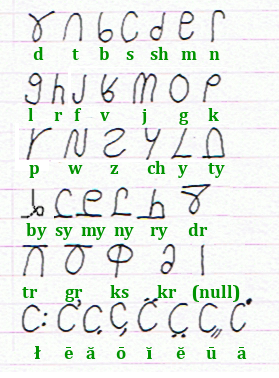
 Languages
Languages

Home | Author | Background | Languages | Features
Conventions | Grammar | Verbal Forms | Modern-Old Tongue Dictionary | Old Tongue-Modern Dictionary | Old Hand
The "Old Hand," as it is called, is so associated with Original culture these days, I felt compelled to include it here, even though it did not exist at the time of this tale. Hosyindre, the crippled, illiterate woman of the Huascarán who invented the writing system of the Originals, was not born until about 1090 AR. Most estimates place the date of completion at about 1148. By her death in 1160 it was widespread through all Original peoples.
Hosyindre originally experimented with pictograms. One surviving manuscript in her hand is a loosely-sewn set of twelve large sheets of paper containing over 250 pictograms each. Next, she experimented with syllabaries, and created a system of over 130 characters. This one she attempted to promulgate, and, indeed, there is a document from 1146 that is apparently a translation of an agreement at the Royal Convocation, written in this early syllabary. However, she found herself continually adding characters, and eventually became frustrated again.
It is said that she had an insight that many of the syllables were simply variations on each other, and that writing might be done by a system that used the same character for all variations, combined with another character specifying which variation. It is thus that the current alphabet was born. In contrast to other alphabets that use diacritics to mark vowels, the Old Hand never existed as a simple consonantal language, but always had vowel diacritics, adopted from common punctuation.
Hosyindre was unable to speak or read the lowland tongue, but she clearly had access to lowland writing, as her final alphabet uses mostly the common letters. She obviously had no understanding of how it worked, however, because she uses it entirely in her own way. Letters have no relation to their common pronunciation, and indeed often majiscule and miniscule letters are combined in different fashion. However, the accusation made by some that this renders the alphabet "invalid," being allegedly based on "error," is simply a racist effort to undermine the brilliance of the woman who created an elegant writing system.
Hosyindre also included a "null" consonant: "|". This was her solution to syllables that began with vowels.
Punctuation, evolving much later, used a bracket "]" to indicate the end of a sentence, parentheses "()" to indicate a quotation, and an em-space " " to indicate a pause such as might call for a comma.
![]() Epijanio
Epijanio
![]() What is benyote fa?
What is benyote fa?
![]() We are all thankful to Hosyindre.
We are all thankful to Hosyindre.

The Old Hand. Green letters indicate the common letter equivalent.
Note that in the chart above, long vowels are indicated by their English standard, in which the long "e" is as in "beet", rather than in the traditional romanization of the Old Tongue, in which the long "e" is as in "bane.
Click here for a guide to Pronunciation
